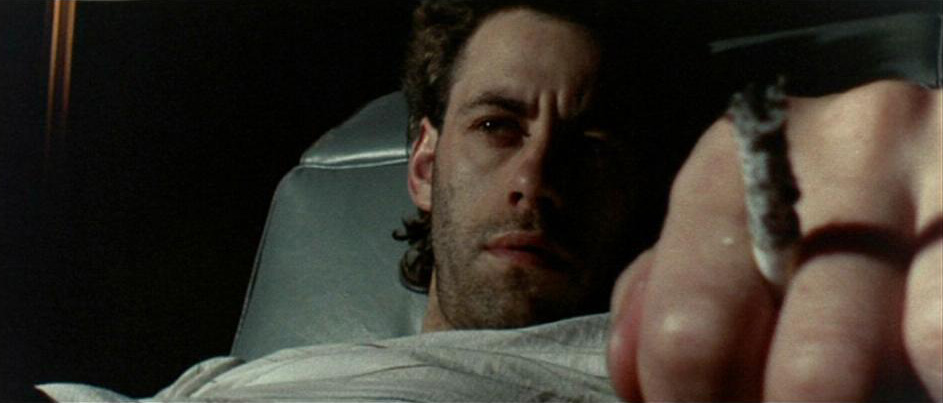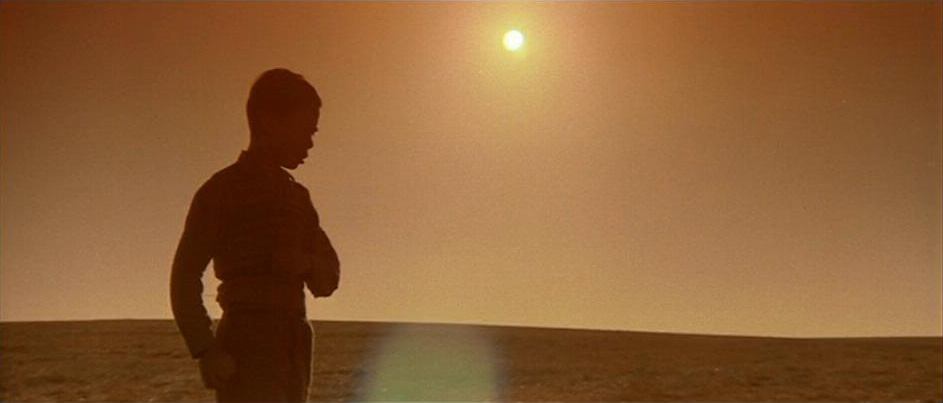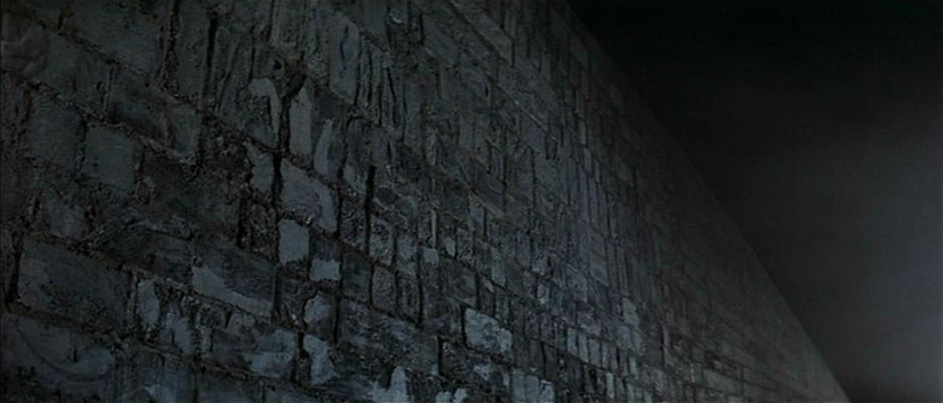Goodbye Cruel World
[Roger Waters]Goodbye cruel world,
I'm leaving you today.
Goodbye, goodbye, goodbye.
Goodbye, all you people,
There's nothing you can say
To make me change my mind.
Goodbye.
Song In A Sentence:
Pink bids farewell to the outside world, locks himself in his hotel room and places the last brick in his mental wall.
T hough a cursory listen to “Goodbye Cruel World” might lead one to believe that Pink is on the verge of committing suicide, the song is more about metaphoric rather than physical death. Having decided to isolate himself completely from the world, Pink sings his final farewell as he arranges the last few bricks in their places. As Waters said in his 1979 interview, Pink is “going catatonic, if you like…he’s had enough, that’s the end.” Similar to the all-encompassing accusations of “Another Brick in the Wall, Part 3,” here Pink says his curiously calm goodbyes to “all you people,” which in one sense is addressed to everyone in his life who contributed to his wall, but in another seems to break the fourth wall (while ironically completing his own barrier) in arguably addressing us, the audience. The first half of the album began with such an address in “In the Flesh?” – Pink warning the concertgoers, and us by extension, about life’s cold-eyed disguises. And so it similarly ends; though rather than a mere warning, we now glimpse the full consequences of being weighted down by those million tear-stained eyes in our protagonist’s heedless readiness to totally severe ties with the world and, thus, reality. But unlike the manic rage of “One of My Turns,” the duel-edged desparation of “Don’t Leave Me Now” and the frenzied abandon of “Another Brick in the Wall, Part 3,” the last song of the album’s first half is decidedly restrained, hinting that Pink is fully resigned to what he sees as his fate. After battling the world and all its betrayals for so long, the thought of detaching himself completely is undoubtedly one that brings tranquility to his myopic mind. Gone are the furious drum beats, the sharp guitar riffs and barbed lyrics. In their place are a lilting bass guitar riff set to the pace of calm breathing, and simple, straightforward vocals momentarily unfettered by any artificial disguises. With his final “goodbye,” Pink places his last brick, abruptly cutting off the music and his farewell, as if we’re stationed on the outside of his wall along with the rest of the “cruel world.” On an album where nearly every song segues into the next via an instrumental or sound effects interlude, the silence that cuts into the end of the album’s first half is instantly jarring, the immensity of Pink’s wall felt in the void where only seconds before a musical life existed. Figuratively speaking, the wall silences all.
Similar to the bookending riots of “In the Flesh?” and “Another Brick in the Wall, Part 3,” the opening shot for the movie sequence of “Goodbye Cruel World” circles back to catatonic Pink watching TV with a cigarette burned to ash all the way down to his fingers. The shot creates a time arc, linking the beginning of the film with the end of its first half, reestablishing the present frame of time and suggesting that all that has happened in between has been in the past. The reintroduction of the scene into the movie shows that Pink had already completed his wall even before the audience came into the movie, adding to the overall sense of futility. The overall sequence for “Goodbye Cruel World” acts as a sort of visual chiasmus (or antimetabole), a linguistic technique by which words or clauses are structurally reversed to draw attention to the larger themes at play. “When the Tigers Broke Free, Part 1” began with a shot of the playing field (A), then cut to a close up of Pink’s cigarette (B), then an overall shot of Pink (C) before zooming in with an extreme close up of his eye (D); “Goodbye Cruel World” partially inverts the order, going from the cigarette (B) to Pink (C) to Pink’s eye (D) to the memory of the playing field (A). And so the first half of the film ends with a reversal of its beginning, mirroring in a sense the regressive decay Pink is undergoing at this point in his narrative.
Although the end of “Goodbye Cruel World” on the album highlights the schism between Pink and the rest of the world with the sudden silence, the song’s ending in the film allows a further glimpse into the very heart of Pink. Seen only in brief flashes in songs like “When the Tigers Broke Free, Part 1,” the playing field scene takes on a slightly more significant role at this point in the film, playing out long enough for Pink to make it across the field and find something on the ground. For the audience, questions still abound as to why this one moment out of a lifetime of moments sits at the forefront of Pink’s mind as he imprisons himself with his last brick. What exactly does this childhood memory emobody that it becomes Pink’s sole thought when faced with self-imposed isolation? In order to find out, the audience must now venture with Pink into the mental darkness behind his wall.
What Other Floydians Have Said
"It's the video sequence at the end of 'Goodbye Cruel World' in which young Pink is running across the rugby field, and stops and glances downward. At that moment, his facial expression seems to be almost one of confusion, as if he's asking himself, 'What am I doing and why am I doing this?' Now, granted that in a later sequence this segues into the depiction of the rat (more on that in a moment,) there seems to be a reason for this incarnation of the sequence that does not apply later in 'Comfortably Numb' -- a specific part of the story that is told in this few dozen frames. The answer to the question 'What am I doing?' is given in the background of the shot -- he's running towards the camera, with the goalposts in the background -- in other words, he's running away from the goal. If we are to interpret the symbolism of 'the goal' in terms of the film's larger statements about a sense of connectedness to the rest of humanity, then Pink's flight from 'the goal' represents his self-imposed isolation. In short, the confused look on his face can be interpreted as his last shred of reason asking, 'Just why am I running away from the goal?'
"Of course, later, when the story of the rat is illustrated in 'Comfortably Numb,' we find that his momentary glance at the ground is to look at a rat he's found, which seems, possibly, to be ill. This rat, representing Pink's only true feeling of connectedness to anything living in his childhood, further illustrates the connection between 'the goal' and what Pink's life truly lacks -- a sense of connectedness. But there is more here -- We see that Pink takes the rat to a safe place, and lets it nest in his sweater. After this, we see the sequence in which Pink is confined to his bed, his mother frantic, and his doctor shooting almost accusatory looks at her. I interpret this similarly to the way you do -- his mother found out about the rat, and became hysterical in her fear that he'd picked up some sort of illness from the rat. Simultaneously, Pink either actually becomes ill, (or perhaps he doesn't, but is confined to bed by his overprotective mother anyway,) or perhaps he even becomes psychosomatically ill (a diagnosis which seems confirmed by the doctor's accusatory looks at Pink's mother. The inference of psychosomatic illness also takes on further meaning when one considers that the layperson's definition of the word 'psychosomatic' is 'disease that's all in the mind.' In a manner of speaking, therefore, we are possibly being shown that ultimately, Pink's sickness is literally 'all in his mind.') At any rate, during the period in which he is confined to his bed, the rat dies, whereupon Pink discards the body, puts his sweater back on, and continues on, almost as if nothing happened. (Symbolic, of course, of Pink's own detachment from those he might otherwise connect with, since for him, connectedness is equated with loss.)
"This also plays into Waters' obsession with cycles -- as 'Don't Leave Me Now' ended on the line, 'Why are you running away,' we find young Pink at the end of 'Goodbye Cruel World' seemingly asking himself the question, 'Why am I running away?' After all, in the end, it is not the rest of the world that has shut Pink out (as he's heretofore convinced himself in his little victim's microcosm that he's built behind his wall) but Pink who has shut the rest of the world out. This also jives better with the placement of 'Hey You' right after 'Goodbye Cruel World,' since the confused look on the boy Pink's face segues naturally into his first regrets at having completed his wall, and his subsequent natural desire to re-connect, expressed in 'Hey You' and 'Is There Anybody Out There?'." - Gos
"The scene with the rugby field where only Pink is shown…the orange sky and the field goal 'H' seem to symbolize Pink’s own personal Hell. The flaming sky and the big H, etc….food for thought." - Don White
"Regarding the playing field, I've always supposed it to be a double reference to two of those things that, once upon a time, 'every schoolboy knew': 1) the Henry Newbolt poem 'Vitai Lampada' - 'there's a breathless hush in the close tonight / ten to make and the match to win / a bumping pitch and a blinding light / an hour to play and the last man in...' It's a corny, late Victorian poem about duty and sacrifice (the boy winning the cricket match, the infantry square that holds its ground against all odds - both share the virtue of being able to 'plat up, and play the game') and fits perfectly with the weight of Tradition / Duty that a British School placed on children up to the swansong of Empire in the 50s, which, of course, Pink rebelled against. 2) Wellington's claim that the Battle of Waterloo was '...won on the playing fields of Eton'. Again, fits the theme of schools being a part of 'The Establishment' and teaching boys to be good Sons of Empire." - Richard Bryson





